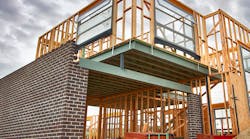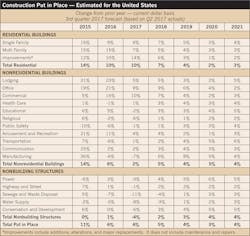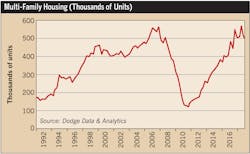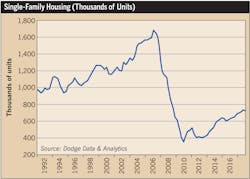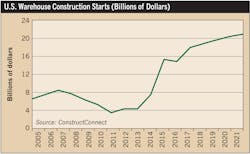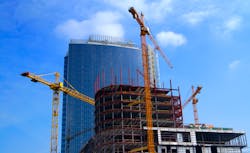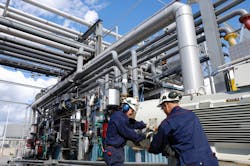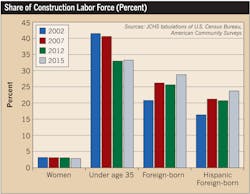The Great Recession squeezed electrical contractors’ profit margins, stopped construction projects in their tracks, and exerted downward pressure on many markets. Gradually, the economy and construction industry began its journey on a slow road to recovery, eventually posting gains — nearly across the board. Eight years later, however, the downturn is still fresh in contractors’ minds, says Kevin Haynes, chief consultant for FMI Corp.
“We had a lot of contractors get burned during the recession, and the scars are still fresh,” Haynes says. “There is a general feeling of uneasiness going into 2018.”
While some contractors fear that a cyclical downturn is imminent, Haynes says FMI doesn’t forecast a significant slide in markets anytime soon. In fact, he says FMI, which is forecasting a 5% increase in construction put in place for 2018, expects continued growth until 2021 and doesn’t anticipate a downturn for at least five years (Fig. 1). When you consider the rate of inflation, which is typically 3% to 4%, however, some market segments are already forecasted to be flat in the near future, Haynes says.
“History tends to repeat itself, and you have a lot of people who look at the cyclical nature of this industry,” Haynes says. “If you peel back the onion, however, there’s nothing that should cause this concern, unlike in 2006, when the lending in the residential industry led to the downturn.”
Growing competition
As some market segments reach their cyclical peak, especially on the private side, more contractors are competing for fewer job opportunities, says Brian Strawberry, senior economist for FMI.
“Growth is slowing, competition is increasing, and the pie is not getting any bigger, so contractors are fighting for market share,” Strawberry says. “Our clients are starting to feel uneasy because they now more often will need to compete amongst themselves.”
To not just survive, but thrive, contracting companies have learned to diversify in not just one or two, but four or five market segments.
“When one is down, another one is up,” Haynes says. “It’s a state of readiness and of being prepared. Hopefully, the recession won’t happen again, but if it does, they hope it won’t have the same drastic impact as before.”
When the construction industry does reach its peak, a slower pace of economic growth and slower job creation would first affect the commercial building sector, says Robert Murray, chief economist and vice president, Dodge Data & Analytics. Initially, he says the institutional building and public works sectors would be resilient to an economic slowdown due to the financing support stemming from recent state and local bond measures. Next year, Murray says the GDP growth is estimated to be 2.6%, which is dependent upon both tax reform and a lower corporate tax rate. In addition, he anticipates moderate upward movement in interest rates. Overall, he expects U.S. total construction starts to edge up 3% (Fig. 2).
“The year 2018 is expected to be another ‘good, but not great’ year,” Murray says.
Residential ramp-up
Within the multi-family housing market, Murray says much of the recent growth reflected a surge of high-rises in downtown areas, but New York has settled back following an exceptional level of starts in 2015. Meanwhile, much of the slack has been picked up by other metropolitan areas, such as Los Angeles, Chicago, San Francisco, and Atlanta (Fig. 3).
“For now, it appears that the multi-family slowdown will stay modest, given the broader contribution that’s taken place geographically,” Murray says.
For several years, the multi-family residential market has been going strong, and the single-family market has been tagging slowly behind, Strawberry says. The tables, however, may be turning for 2018, Strawberry says.
“Going forward, we see the steam running out of the multi-family segment and more of a long-term continuation in single family,” Strawberry says. “We have seen a lot of the bigger cities built out with condo space and apartments, but there is still room for single-family development on the perimeter of larger cities.”
Haynes agreed, saying for 2018, FMI forecasts a 5% growth for multi family compared to a 7% bump the year before.
“The growth will not stay as strong as it has been,” Haynes says. “There was such a strong build-out from 2012 through 2016, and my gut feeling going into 2018 is that we will see a lot of projects wind down.”
In terms of the residential market, one factor may soon contribute to heightened activity within this sector — the millennial generation.
“There has been a lot of hope placed with millennials, who have been living in their parents’ basements or college dorms,” says Alex Carrick, chief economist for ConstructConnect in the November 2017 Webcast, “2018 Construction and Design Outlook: Cheery or Dreary?” “They are now starting to enter the workforce in greater numbers.”
Currently, however, Carrick says that many millennials are content with temporary jobs, which typically don’t pay enough to cover a mortgage payment.
“If millennials decide they want to have single-family housing like their parents and grandparents, it will help to drive residential starts,” Carrick says.
Far more millennials, however, are either not ready to commit to home ownership, have delayed having families, or have not yet found their ideal long-term job, says Dr. Kermit Baker, chief economist for the American Institute of Architects.
“Because they may be unsure about whether to live in a certain city, they decide to rent, rather than buy, a home,” Baker says.
While the younger millennials may opt to continue renting, the older members of the generation are now in their 30s. As such, many are looking increasingly at home ownership (Fig. 4), Murray says.
“Following the excessive levels of construction that occurred during the prior decade, the recovery for single-family housing has been subdued to date,” Murray says. “But when millennials start buying homes, it could lift demand for single-family housing.”
Stretching over a decade, housing starts were less than 1.4 million units, which was what was needed to satisfy population growth and family formation, Carrick says.
“The accumulated shortfall is 5 million units, which is three normal years of housing starts, so if it ever really gets going, it will drive the economy for years to come,” Carrick says.
Another bright spot in the residential market is renovation work, which Baker expects to be a hot market for 2018.
“The real growth star in residential construction is in additions and improvements,” Baker says. “With those with moderate income, a lot of it will convert over to upgrading existing units rather than building new ones.”
Slight commercial uptick
Commercial construction plunged from 2008 through 2010, then rebounded from 2011 to 2014 as the market recovered from its crash, Murray says. After reaching a more mature stage of expansion in 2015 and 2016, he says he expects this market segment to advance only 2% in 2018.
“In 2017 and 2018, the commercial sector is likely to edge slowly higher as it nears the coming peak,” Murray says.
Store construction continues to be affected by two factors — the glut of retail space that was created during the previous decade and the structural change reflected by the shift to e-commerce, he says.
“Store construction is expected to remain close to this year’s subdued amount in 2018,” Murray says. “The one bright spot for store construction is that store renovation work has continued to increase, reflecting the increased stock of retail space and the shifting uses of that space.”
“The brick-and-mortar section of retail has been suffering as of late,” Carrick says. “It’s not just that stores are being closed or outlets have been shut down, but the problem is the overhang — the empty space that must be filled before there is new construction.”
At ConstructConnect, Carrick says his forecast for retail is weak for stores, yet strong for warehouse construction (Fig. 5).
Strawberry says the warehouse niche is growing faster than all the other subcomponents, likely due to the growth of e-commerce. In some areas of the country, he is also seeing a demand for localized, smaller warehouses to provide swifter delivery.
Simonson is also seeing the trend shift from million-square-foot distribution centers to click-and-connect points inside metropolitan areas to deliver shipments the same day. Self-storage units have also experienced growth within the warehouse sector, he says.
Another commercial market, the office sector offers the highest growth in the non-residential market with a projected year-over-year growth rate of 9%, according to FMI. Haynes is seeing the cyclicality of the office sector run behind other commercial segments, such as lodging, which has a projected 5% growth in construction starts.
Haynes says data centers are driving the growth both today and likely in the long term. In addition, Strawberry says the trend toward the construction of mixed-use developments is still prevalent.
Within the private office market, Carrick says in the past, it was driven by the need for office space for financial, architecture, engineering, computer, and legal systems, but going forward, the demand will likely stem from the high-tech sector, where there has been strong employment growth.
“The next sign-of-the-times jobs like software publishing and biotechnology resources require office and lab space, and there is work in those pockets of construction,” Carrick says.
The office market is still growing, but at a slim margin, says Ken Simonson, chief economist for the Associated General Contractors of America. While some companies are relocating their headquarters, he says many are allocating less square footage for employee because more employees are working remotely.
“This zaps the growth of office construction demand as more people are working in co-working spaces or from home,” Simonson says. “The market for high-rises and office parks in the suburbs remains very cold.”
Within the lodging market, Carrick says hotels and motels may have hit a high level in 2017, but it remains a highly cyclical category of construction.
“When one hotel operator decides to expand, others jump on the bandwagon,” Carrick says.
Institutional impact
Going into 2018, Strawberry expects some markets to experience gains, particularly in the public sector.
“We anticipate next year will be a touch better than this year,” Strawberry says. “Several of the public markets have been held back for various reasons, and we expect them to rebound a bit.”
For example, Strawberry anticipates health care and education to lead the institutional market, while infrastructure, particularly power and highways, to rebound. Within health care, Strawberry says it has been an extension of the wait-and-see mentality as the country has experienced uncertainty surrounding the repeal and replacement of Obamacare.
While Haynes doesn’t expect the health care market to “go gangbusters” next year, he says some metropolitan areas, such as Dallas, are healthy in terms of project volume. Everywhere else, he’s seeing smaller health care projects than during other periods in history.
“The trend is toward smaller projects on the health care side,” Haynes says. “These are being pushed out into the community through clinics and ambulatory facilities and moving away from traditional hospital settings.”
While the hospital market has stayed flat or declined, Baker says he’s seeing more stand-alone emergency care facilities, surgical offices, and rehab centers and clinics inside drug stores.
“The growth on the hospital side will be marginal, but there will be growth in special care facilities,” Baker says.
As the U.S. population ages, Carrick foresees the need for more health care facilities. To make these projects as cost-efficient as possible, he says some owners are shifting toward modular construction, in which bathrooms are built off-site in a manufacturing plant.
Murray says the health care market experienced moderate growth in 2017 for two reasons — the need to go ahead with projects for competitive reasons and to accommodate new health care technology. The uncertainty swirling around the overhaul of health care will have an impact in 2018.
“Improved levels of construction will proceed hesitantly at best, with 2018 anticipated to be essentially flat,” Murray says.
Another institutional market — education — was one of the significant year-to-date surprises in the forecast update, Strawberry says. For 2018, he anticipates more normal growth rates in the 3% to 4% range, but for 2016 to 2017, the year-to-date numbers were down.
“We are seeing a lot of volatility in the education market at the local level,” Strawberry says. “We are seeing bigger projects in higher education and more spending, but on the K through 12 side, states and municipalities are having a harder time with funding.”
Simonson, however, expects more growth in pre-K through 12 spending, driven by rising property values. On the higher education side, he says the enrollment has declined 21% from 2011 to 2016, lessening the need for more classrooms and dorms. On the private side, however, he forecasts that rising stock prices will boost endowments and capital campaigns.
The educational building market should see stronger growth in 2018 due to financing from state and local bond measures, Murray says. Also, he says college and university construction projects will benefit from improved investment returns for college and university endowments.
Powering the market
Within the power sector, several factors could fuel growth, including the green light for the Keystone Pipeline project, the start of many transmission line projects and a potential surge in natural gas power plant construction.
“There is a lot to consider with power, and while long term it’s more positive, this sector also carries a lot of risk,” Strawberry says. “If something goes wrong in the power segment, it could have a much larger effect on the total U.S. construction market.”
After several years of elevated construction starts, the current slowdown in the electric utility sector is not surprising, considering the new capacity coming online, Murray says. Capacity utilization rates for electric power generation and distribution are now about 75%. On the positive side, however, state portfolio requirements regarding the mix of electricity generation, such as natural gas, wind, and solar, will offer ongoing incentives to go ahead with new power plant projects. Meanwhile, on the transportation side, Haynes doesn’t forecast a high level of activity.
“There’s still a lot of talk and not a lot of action,” Haynes says. “I don’t see that changing as far as streets and highways. Unless there is a widespread adoption of a financing mechanism, which could cause a significant increase in spending, I think it will stay flat in this sector.”
Murray says any benefit to public works from the passage of a Trump infrastructure program will take time to have an impact at the construction site.
“The initial benefit would be modest, and the extent would depend on how much the program includes direct federal funding as well as incentives to increase private funding,” Murray says. “Congress will also have to find ways to shore up the Highway Trust Fund, which might involve raising the federal gasoline tax for the first time since 1993.”
Over time, Carrick says advances in technology have changed both the construction market and the economy. Case in point: Automated vehicles may just be around the corner, which will change the need for more sensors to monitor traffic, further creating opportunities within this sector. The airport sector is also showing promise going into 2018, Carrick says.
“All around the world, there are airports under construction,” he says. “Almost every airport is being expanded, or new runways or roadways are being fixed up. This will be a strong area of growth for many years to come.”
Because airports are largely self-funded, they earn taxes or rent from the retail stores inside the terminals, parking and rental cars and passenger facility charges, Simonson says.
“The airports are modernizing by speeding passage through the security lines, adding gates, improving access roads or car rental facilities, and adding new control towers and de-icing technology,” Simonson says.
Stimulating manufacturing
While there is uncertainty across many different sectors, one thing is for sure — President Trump is focusing a lot of his attention on manufacturing construction, Carrick says. He says the president is working to put America first in manufacturing through international trade agreements. Stimulating the manufacturing industry domestically, however, offers its share of challenges.
“Total manufacturing is way down, and it’s hard to get those jobs back,” Carrick says. “Some parts of manufacturing have been skyrocketing, but while the employment has improved, it’s nothing like it was at the beginning of this century.”
Murray says three factors should support manufacturing plant construction in 2018 — the improving export picture, stable oil prices, and some easing of the U.S. dollar. He expects construction starts for manufacturing to slide back 1% after posting a 27% gain. The renewed growth for petrochemical plants pushed the dollar amount higher in 2017, and several projects are underway for 2018 as well.
Moving into 2018, Murray says it’s not an easy task to determine when the construction industry will hit its cyclical peak, since some markets are gaining momentum while others are declining. During 2017, however, only two markets — multi family and hotels — began to head downward after apparently reaching their respective highs back in 2016.
“In the current environment, there are still positive factors to suggest that the construction expansion has room to grow in 2018,” Murray says.
Fischbach is a freelance writer and editor based in Overland Park, Kan. She can be reached at [email protected].
SIDEBAR 1: Hurricanes Could Have Lasting Impact on Construction Market
After back-to-back hurricanes flooded homes and destroyed buildings in Florida and Texas, construction economists are still considering the impact on future construction activity. Brian Strawberry, senior economist for FMI, whose parents realized significant losses on their home in Marathon, Fla., says many houses are completely unlivable due to the wrath of the hurricanes.
“I actually strengthened our forecast for 2018 and somewhat in 2019 because of the cost of rebuilding parts of Florida and Texas,” Strawberry says. “I think the rebuilding efforts will take the better part of two years to get back to where we were, and the rebuilding will be expensive because of the lack of labor and the demand for material.”
The rebuilding this time around, however, will be different than after Hurricane Katrina devastated New Orleans, says Kevin Haynes of FMI. Back then, the rebuilding effort focused more on civil, non-building opportunities, such as levees and sea walls, to prevent the same level of damage from happening again.
“With Florida and Texas, the work will be more widespread, and it will be more based upon the general construction damaged by the storm,” says Haynes.
When you look at Hurricanes Harvey and Irma, Dr. Kermit Baker, chief economist for the American Institute of Architects, says they are two of the most costly natural disasters on record. Because not all the losses are insured, they may not ultimately end up in repair or replacement, he says. For those structures that are rebuilt, however, he expects it to be a long-term process.
“Rebuilding occurs slowly,” he says. “It’s not measured in months and quarters, but in years. It will be a fairly long lag before we see this activity occur.”
So far, not much impact has shown up on the national construction employment costs from the recent hurricanes and the wildfires in California, says Ken Simonson of the Associated General Contractors of America.
“There will be impacts on the directly affected areas, but the impact on the rest of the country should be minor,” Simonson says. “The short-term impacts are more on reconstruction, which puts pressure on material and labor prices, and long-term impacts refers to rebuilding.”
Robert Murray, chief economist and vice president of Dodge Data & Analytics, says the impact of Hurricane Harvey and Irma is still being evaluated, and estimates of property damage vary widely. For example, in Houston and Florida, a lot of the destruction occurred to single-family housing, while the downtowns of Houston, Miami, and Tampa experienced relatively minor damage.
The pattern shown by past hurricanes — such as Hurricane Andrew in 1992, Hurricane Katrina in 2005, and Superstorm Sandy in 2012 — indicates that the recovery process gets extended over several years, not months, Murray says.
“In terms of the impact on construction, Hurricanes Harvey and Irma do not appear to have had much of a negative effect on commercial and institutional building projects, as work that was briefly postponed seems to have resumed,” Murray says.
The impact of the hurricanes on single-family housing, however, may provide a positive benefit to construction with an additional 10,000 starts over the next year or two. But the fact that many homeowners did not have insurance means that the reconstruction of destroyed homes will be limited, Murray says. Through disaster-relief measures passed by Congress, storm sewer work and other environmental public works projects will also likely get a lift due to greater attention on the basic need for the projects, he adds.
SIDEBAR 2: The Skilled Labor Shortage: The Challenge Continues
While America has made some progress in rebuilding the labor force, it will require more extraordinary measures beyond rebuilding traditional training programs to resolve the problem, says Dr. Kermit Baker, chief economist for the American Institute of Architects.
“We not only went through the Great Recession six or eight years ago, but we see some additional challenges in terms of demographic trends,” he says.
• Half of the nation’s workforce is comprised of women, yet only about 3% of today’s construction workers are female, and this percentage hasn’t grown over the last decade.
• As the construction workforce has gotten older, the focus has been on recruiting millennials, but many are not showing interest in construction.
• The construction industry is more reliant on immigrants than any other industry in our economy besides agriculture. In fact, he estimated that a quarter of the construction workforce is staffed by immigrants. In the future, revised immigration policy and enforcement could have an impact on the rebuilding of the construction labor force.
